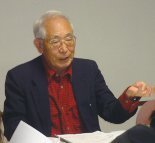

1.My Childhood Dream
I entered a national elementary school in 1945, which was the year Japan was defeated in WWII. I was obliged to transfer schools three times when I was in first grade because of food and housing. Since my father was a sailor, I lived in an old port town in Toyama prefecture from second grade. Every morning, I looked forward to see the ships enter the port from uphill and would go check out the foreign ships that came in every now and then. I dreamt to visit foreign countries in the future like the ships I saw. As you can see, I was brought up with the ocean, harbor, and ships during my childhood years.
2.Two Encounters of Cross Culture at Doshisha University
I applied to the Faculty of Commerce at Doshisha University in April 1959 with the desire to play an active role in the trading world. However, I met with Christianity for the first time in my life during Chapel Hour.
Since then, I couldnft shake off the interrogation. I attended three bible lectures at the religion center to deepen my understanding. At the time, Christianity itself was a different culture to me.
I chose to study Spanish because my goal after graduation was to work in a commerce department at a trading or manufacturing company. My professors were Mr. Ooshima, Professor of Spanish literature and Minoru Chonan, Professor at Tokyo University for Foreign Studies. I failed the exams over and over and consequently ended up studying for four years. But studying Spanish broadened my world and allowed me to open my eyes to Latin America.
became more interested in Latin America history especially with the impact of the outbreak of the Cuban Revolution in 1959. Ifm still in the process of studying Professor Chonanfs version of Historia de lasIndias, which took him ten years to translate. I was given this opportunity owing to the new encounters of cross culture of Christianity and Spanish at Doshisha University.
3.The Liberal Arts of Amherst House and International Spirit
I wasnft a Straight-A student but I probably lived the best student life at the time. I lived as a dormitory student from April 1960 to March 1963 under Otis Cary, the director of Amherst College.
The Liberal Arts through the three years of heart-toheart community life with the Carysf, Amherst Fellows, dorm students had such a great variety of international programs that it was impossible to count them all. It was clearly expressed in the gPresentation letter from Amherst Collegeh below, which was sent from the President of Amherst College to the President of Doshisha University (Gintaro Daikuhara) on May 21, 1932. The international spirit of the Amherst House began in November 29, 1931 and the ceremony to mark the laying of the cornerstone of Amherst House was held along with the 56th anniversary ceremony of the founding of Doshisha University.
Presentation letter from Amherst College (An excerpt)
Joseph Hardy Neesima, the founder of Doshisha University and Stewart Burton Nichols, one of the Professors at Doshisha University until recently and student representative of Amherst College, have donated a total of forty thousand dollars together (divided into a few times) to commemorate and to promote their wish to present a building to Doshisha University. . . Our wish is that the buildings, which will be entrusted to authorities of like-minded people, will forever maintain a friendly spirit between the United States and Japan, Doshisha University and Amherst College, and to be utilized to increase good will. We also wish for the building to create a common ground of culture, thoughts, and ideals for Eastern and Western countries and to become a mean to increase mutual understanding and tolerance within both people. (Cited from the Amherst Spirit)
4.Friendship with Latin America
After I graduated from college, I worked at JETRO for about thirty-nine years. Within those years, I resided in Ecuador and Brazil for a total of eight years and was blessed to visit fifteen countries in Latin America to develop the Japanese import market and trade promotion business.
There were countries including Peru where I visited more than ten times. Latin America made an appearance in world history due to Cristobal Colonfs discovery of America but a world of Azteca, Maya, and Inca civilization existed before.
But sadly, the civilization became extinct due to the Spanish conquerors. Various countries of Latin America became independent in the beginning of the 19th century after overcoming three hundred years of the colonial period.
Afterwards, Latin America finally established a democratic nation at the end of the 20th century while fighting against the supremacy principle and the control of military strength of the Great Powers of the West.
In the 21st century, a descendant of an Inca, an aborigine, became the President of Bolivia and a female President was assumed in Brazil in January 2011.
Latin America welcomed Japanese immigrants during the difficult times of the Meiji Period. But above all, there are more than 1.5 million Japanese-Brazilianfs who approached 100 years of immigration and now plays an active role in a wide range of fields such as politics, finance, education, and the judicial circles.
My small childhood dream was materialized in Latin America and I was lucky enough to have the opportunity to make good use of the Spanish I learned at Doshisha University. (Reprinted from gthe Cross Culture News No.11h on Dec. 1, 2010)